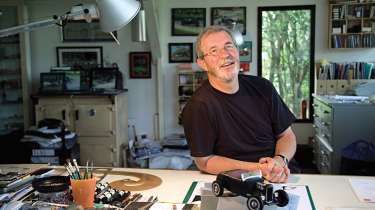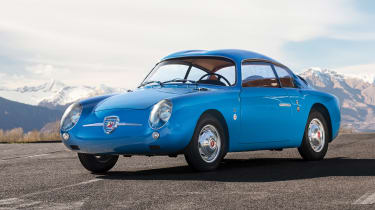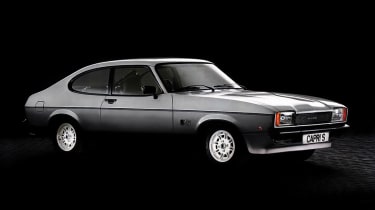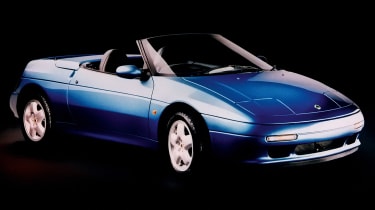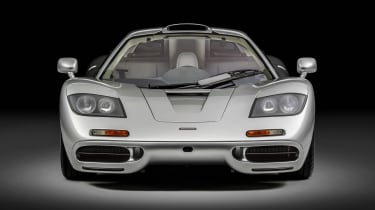My Life & Cars – Peter Stevens, car designer
Following tutorage from some of the finest artistic talent during his college years, Peter Stevens emerged to become one of the country’s leading car designers
'I was born in Macclesfield because that’s where my mother was sent while my father was in the army. He’d been one of the last people out of Dunkirk. I didn’t realise until much later that I was born at the same time and place as future racing driver and sponsorship guru Guy Edwards. There’s a photograph I have of a nurse holding two newborn babies in her arms and in one is me and in the other is Guy. One day I’d end up designing racing livery for him.
My father was a painter, a good one, but you couldn’t earn a living and support a family doing that so he ran a furniture museum in the East End. He wasn’t particularly interested in cars but my mum’s younger brother was. His name was Denis Jenkinson.
According to my grandmother my first words were ‘Look, Jeep!’ She bought me a Dinky Jeep, which I’ve still got. When Jenks realised that I was interested in cars and mechanical things he used to come around – we were living in St John’s Wood by then – to show me what he was driving. One time he turned up in the mid-engine Rover concept. I saw a lot of Jenks.
> My life in cars – Jean-Pascal Dauce, Alpine chief vehicle engineer
I didn’t know there was such a thing as a car designer but my uncle proved to me that you could actually earn a living with cars. He fuelled the passion for cars and perhaps from my father I got the skills in art. Anyway, I went to the Central Saint Martin’s School of Art. It was an amazing time to be there. Peter Blake was my painting tutor and Anthony Caro my tutor for sculpture. You covered all the disciplines at the school.
I really enjoyed sculpture so after Saint Martin’s I went to the Royal College of Art to study product design under Misha Black, the industrial designer who, among other works, designed the Westminster street signs and the underground trains used on the Victoria line until 2011.
The girlfriend of Charlie Watts [of the Rolling Stones] was in the sculpture school and David Hockney was a student there, too. Pete Townshend used to come in driving his Lincoln Continental convertible. Hockney had an American boyfriend who had brought to England his metalflake green Ford Model T hot-rod, which was often parked in Kensington’s Jay Mews. When I was younger I’d bought a copy of Hot Rod in one of those newsagents in London that has an eclectic mix of imported magazines. Reading it fuelled a love of hot-rods and custom cars that’s never left me.
It was in the last year of this four-year course that someone from Ford visited the college with a view to starting a vehicle design course because the company didn’t have a formalised way of training young designers. I and my friend Dawson Sellar were chosen to be the first students on this two-year postgrad course.
Ford actually paid us for doing the course and the money was fantastic for the time: £1200. I immediately went out and bought an Abarth 750 ‘Double Bubble’ and Dawson bought himself a Porsche 356 Speedster. After we graduated we both went to work at Ford’s Design Centre in Dunton. One day later that year it snowed heavily one afternoon and when we left work we found loads of people skidding around a snow-covered car park in their Mk1 Escorts. Dawson in his Speedster and me in a Baja Beetle that I’d bought had no such grip issues with our rear‑engined cars. These cars were hated by almost all at Ford, particularly when we just drove away!
They said that if you wanted to get on at Ford you had to stay for life, which many people did. Dawson didn’t hang about and went to Porsche, where among other projects he worked on the interior of the 928. Back in Essex one of my first jobs was the interior of the first Granada, a rather less exotic machine than the Porsche. However, I was very proud of the very nice winding handle that I did for the car’s sunroof, but rather ashamed of the square headlights on the Mk2 Capri that were also my work.
My mentor at Ford was a Jamaican-born designer called Ron Saunders. He was certainly the only black designer at Ford and probably in the world. He was brilliant at drawing, a complete natural. He had a Lotus Seven but he and I would often borrow a Twin Cam Escort each and go and mess about on Duxford airfield in them. It was hanging around with Ron that made me terribly aware of racial prejudice. We once went to a pub in Hampstead and the barman made a big thing about not understanding Ron’s heavy West Indian accent. The barman turned to me and said: ‘What’s your mate trying to say? I can’t understand a word.’ I replied that Ron had asked for two beers and that he could f**k off because we were going somewhere else.
We were very impressed by what GM were doing. Ford brought out the Mustang and GM did the Camaro, which was a much better piece of design. Same with the Capri and Opel Manta. Ron and I had a theory that when GM’s designers encountered a design issue they removed clay to sort the problem whereas at Ford they added it.
While I was at Ford I worked on the liveries for the Broadspeed and Alan Mann racing Escorts. I’d always loved racing of all types and used to get given free tickets for events such as the BOAC 500 at Brands Hatch and even F1 races also at Brands. When we were young my brother [who was also arty and became a picture restorer] and I were obsessed with Colditz and used to forge our own bus passes just for the fun of it. We also copied the Jenks-supplied race tickets.
I stayed at Ford for a year after Dawson Sellar and then left for Ogle Design. There I worked on the Reliant Kitten and a stillborn sports car that had a wedgy shape and looked a bit like the Esprit. We also did trucks at Ogle, which was a very interesting and useful experience because these are products that people actually have to earn a living with. I even worked on a knitting machine and on Mogul toys, which were rivals to the successful Tonka toys. Doing all this varied stuff really helps with the imagination.
In around 1976 I went freelance and did all sorts of projects, from working with ERF trucks to doing the graphics at Brabham for Bernie [Ecclestone]. In the early ’80s I got involved at Lotus, who were in a right mess after the death of Chapman in ’82. He was such a figurehead and so in control that people were running around saying things like, ‘How do you turn the lights on in the boardroom?’ At the time they were working on an affordable sports car or modern Elan. I was brought in as a freelance but I ended up creating a whole design department.
When I went to Lotus I was plagued by the fixation that ‘Italians are the masters of design’. I wanted to escape from that, which is a reason why I rounded off the Esprit when I did the facelift. It made the car stiffer, too. I was very proud of what we did with the Elan, especially the Mk2. Lotus had a lot of clients with front-wheel-drive cars and by this time had got very good at engineering them. Especially John Miles.
John and I had been at primary school together and in the ’60s I used to go help him when he was racing his Austin Seven vintage race car. I remember trying to push-start him in a paddock and by the time we got it going the race was over.
The Jaguar XJR-15 is another one that I think was a job well done. We did it with a very small team and a tiny amount of money. But I’d still like to do an amusingly rational car. My favourite Giugiaro cars are his rational stuff like the Panda and original Scirocco. I’ve got a 2CV van and that’s the sort of thing I’m thinking of. Perhaps with three seats.
There aren’t a huge number of modern cars that I find interesting. The retro cars such as the Mini and Fiat 500 seem to me like going through the dressing-up box in the loft, pulling out various bits and adding them all up.
I also don’t buy into this idea that the EV revolution is an opportunity to create a new era of novel designs. The huge battery packs tend to go in the same place because of the weight – you can’t start sticking batteries in the A-pillars or doors for example. It’ll be interesting to watch what happens.
Meanwhile I’m still in love with hot-rods and right now should have been at a vintage beach race in France with my Model T roadster, but the virus has knocked that on the head. I shall be going next year instead.’
